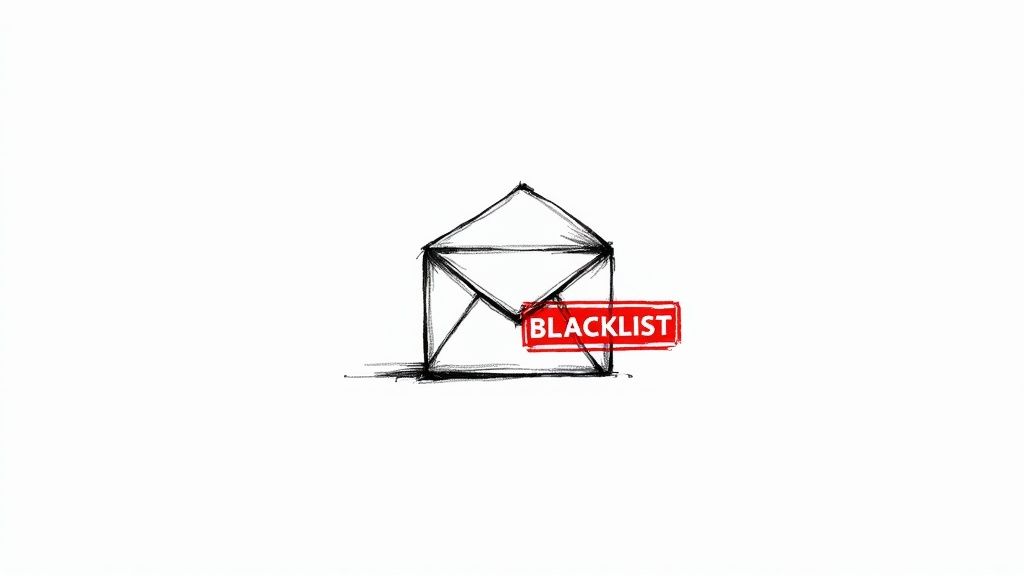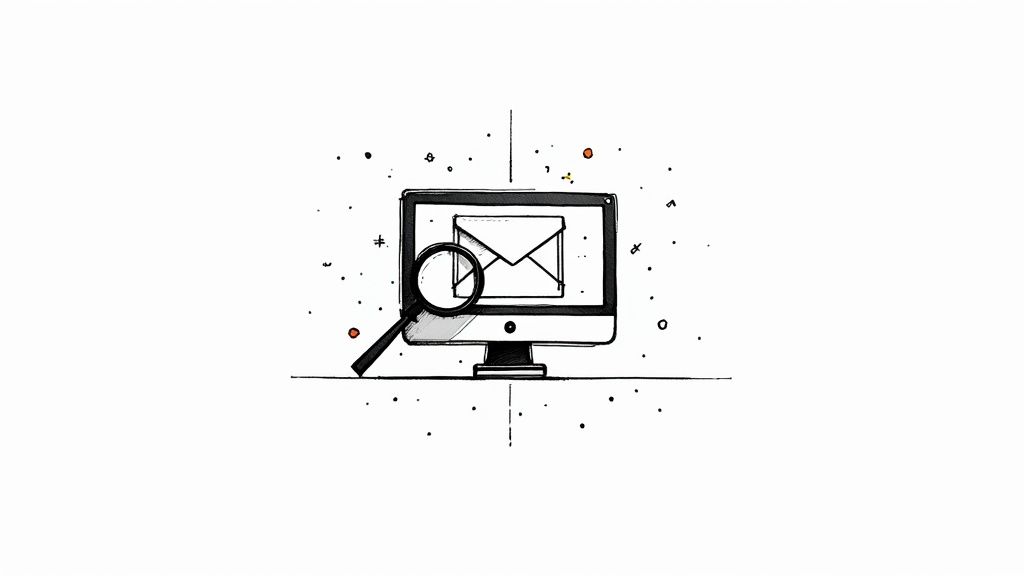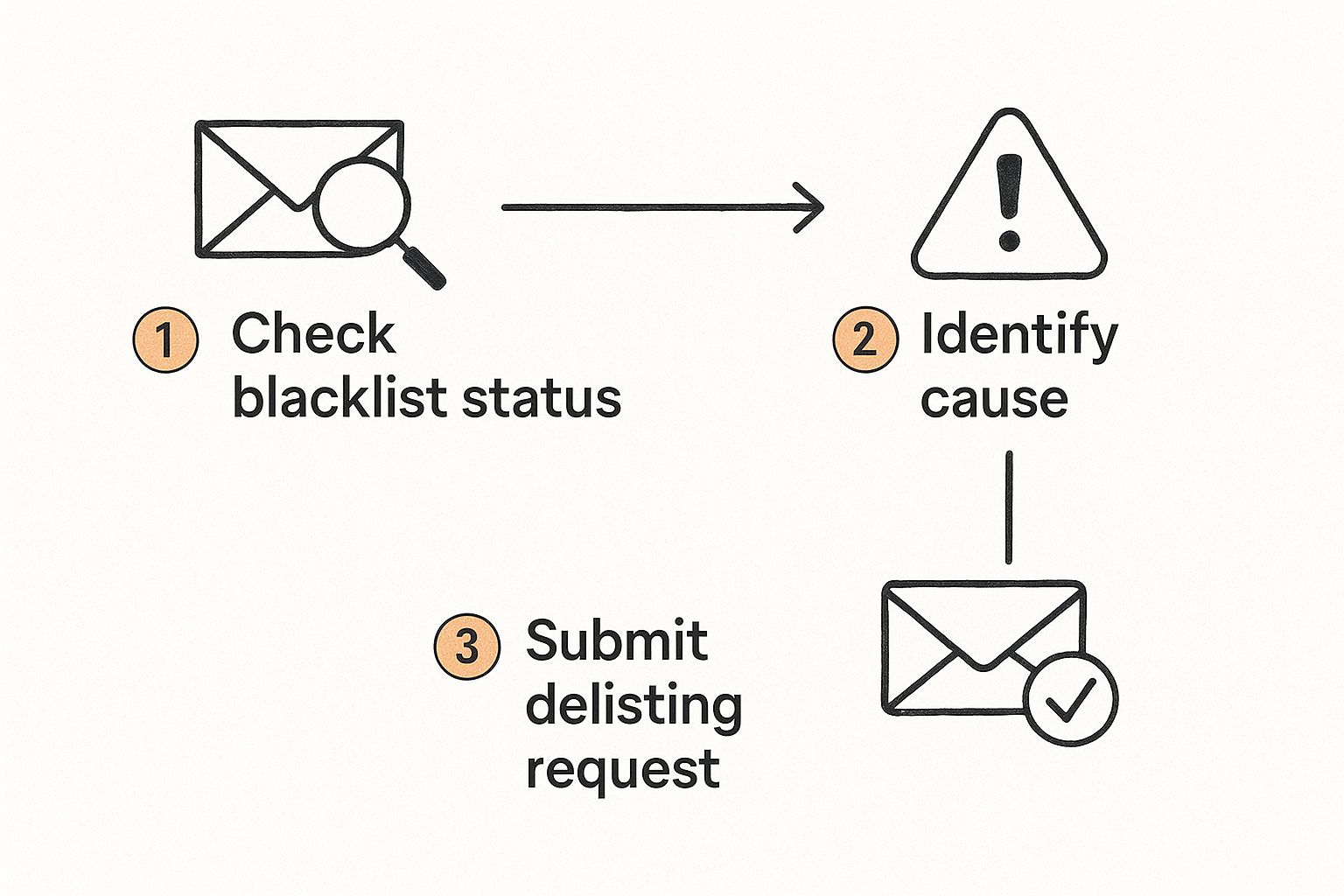So, you need to figure out if your domain or IP address is on an email blacklist. The quickest way is to use a free online tool to run an email blacklist check. Just plug in your domain name or sending IP, and these tools will scan hundreds of common blacklists. This gives you a fast, clear answer to the question, "is my email blacklisted?" and is the first real step in diagnosing why your emails are suddenly hitting the spam folder.
Why Staying Off Email Blacklists Matters

Have you ever poured hours into a critical email campaign, only to discover it never even reached your audience? The silent killer is often an email blacklist.
These aren't just minor technical headaches; they're major business roadblocks that can seriously tarnish your reputation and hit your bottom line. When your site is blacklisted, your line of communication with customers, prospects, and partners gets cut off.
Think about what that really means. An email domain blacklist check could reveal that your entire company’s ability to send email is compromised. We're talking everything from marketing newsletters to essential transactional emails. It's a direct path to lost sales and very unhappy customers.
A blacklisted email domain is more than an IT problem—it's a direct threat to your revenue and brand credibility. Every blocked email represents a missed opportunity to engage, convert, or support a customer.
Keeping a clean sender reputation became even more vital in 2025 as Internet Service Providers (ISPs) cracked down harder on blacklist spam. These blacklists are essentially massive databases that list IPs or domains known for sending junk. To give you some perspective, a service like CleanTalk once reported blacklisting 92 IPs and 304 blacklist email addresses in a single day. That shows just how much traffic is constantly being filtered.
The Two Types of Blacklists: IP and Domain
When you run a blacklist email test, you’ll see listings fall into two main camps. Knowing the difference is crucial for fixing the problem.
- IP Address Blacklists: These target the unique address of the server sending your emails. This gets tricky if you’re on shared hosting, because someone else’s bad behavior can get your shared IP blacklisted. An ip email blacklist check is the first thing you should do if you suspect this is happening.
- Domain Blacklists: This one is usually more serious. It flags your actual domain name (like
yourcompany.com). This affects all emails sent from your blacklist domain email, no matter what server or IP you use. A domain blacklist search will confirm if your brand name itself has a red flag.
Landing on either list means you need a plan for blacklist email removal. But first, you have to figure out how you got there.
Common Reasons for Being Blacklisted
Even legitimate senders can find their domain on a blacklist, and it's often due to simple, unintentional mistakes.
For instance, a sudden, massive spike in your sending volume can look pretty suspicious to spam filters—it mimics the exact behavior of a hacked account blasting out spam.
Another classic pitfall is poor list hygiene. If you’re sending emails to old, inactive, or just plain invalid addresses, you’re bound to hit a spam trap. These are email addresses set up for the sole purpose of catching spammers. Hitting just one can land you on a blacklist instantly.
If you have a blacklisted email address, proactive management is your only real defense. To get ahead of these issues, take a look at our guide on the ultimate email spam avoidance tips and best practices. Understanding how to dodge these common mistakes is the best way to protect your deliverability.
How to Check if Your Email or Domain is Blacklisted
Been seeing a drop in your open rates and starting to ask yourself, "is my email blacklisted?" It's a frustrating feeling, but it's time to stop guessing and start checking. The good news? You don't need a degree in computer science to figure this out. There are some fantastic, easy-to-use tools out there that do all the heavy lifting for you.
Running an email address blacklist check is your first move when deliverability takes a nosedive. Think of it as a diagnostic test. These tools scan hundreds of known blacklists at once, searching for either your sending IP address or your domain. In just a few minutes, you’ll know for sure if your site is blacklisted, giving you the proof you need to start fixing things.
How to Check if You're on a Blacklist
The whole process to check email blacklist status is surprisingly simple. Most tools just need your IP address or your domain name to get started. Your IP is the unique address of the server sending your emails, and your domain is your brand's home on the web (like yourcompany.com).
Here’s the game plan:
- Know What to Check: Are you checking your sending IP or your domain? To check if domain is blacklisted, you'll use a domain-focused tool. If you suspect a server-level problem, start with an ip email blacklist check. If you're more worried about your overall brand reputation, a domain blacklist search is the way to go.
- Pick Your Tool: There are several solid, free services out there. Two of the most trusted names in the game are MXToolbox and SenderScore.
- Run the Scan: Just pop your domain or IP into the search bar and let it rip. The tool will then check against a massive network of mail blacklist operators.
This simple step is the difference between fumbling in the dark and having clear, actionable data. It’s the only way to know if a blacklist email issue is what's kneecapping your campaigns.
Using an Online Blacklist Checker
Let’s walk through a real-world example. When you run a blacklist email check, the tool spits out a results page showing every list where your domain or IP might be flagged.
Here’s what a typical results screen from MXToolbox looks like after a blacklist check.
You'll see a long list of blacklists with a status next to each one. A green "OK" means you're in the clear. A red "Listed" icon? That's your problem.
But the real insight isn't just if you're listed—it's where. Getting flagged by a major player like Spamhaus will wreck your deliverability far more than a listing on some tiny, obscure list. Understanding these results is just as crucial as knowing how to test your email deliverability to see the full impact of these listings.
Pro Tip: Don't treat this as a one-and-done task. Make running an email blacklist check a regular part of your routine. Consistent monitoring helps you catch problems right away, long before they can do serious damage to your sender reputation.
Comparing the Best Email Blacklist Check Tools
When you need to check an email address for blacklist status, having the right tools in your corner makes all the difference. Here’s a look at some of the most reliable options out there, what they do, and when to use them.
Using a couple of these tools together gives you the full picture. For instance, an email domain blacklist check on MXToolbox might reveal a problem, which you can then dig into deeper by checking your IP's reputation on SenderScore.
This multi-tool approach is essential. Once you've diagnosed exactly which blacklist email domains are flagged, you can finally move on to blacklist email removal. But it all starts with a thorough check.
Decoding Blacklist Results and What They Mean for You

So, your email blacklist check came back with a red flag. Before you hit the panic button, take a deep breath. Seeing your domain on a blacklist doesn't mean your deliverability is toast forever.
The first thing to understand is that not all blacklists are created equal. Some are genuine roadblocks that can bring your email campaigns to a screeching halt, while others are more like minor speed bumps. Gauging the real-world impact is your first move.
Differentiating Major from Minor Listings
Think of it like this: a listing on a massive, influential service like Spamhaus is a serious problem. We're talking about a list used by thousands of major Internet Service Providers (ISPs) and corporations across the globe. Getting on their bad side can be devastating. On the flip side, a flag from a smaller, obscure blacklist might barely make a dent in your overall delivery rates.
Here's how I typically break them down for clients:
- High-Impact Blacklists: These are the big players—Spamhaus, Barracuda, SpamCop. A listing here means a huge chunk of your emails will likely get blocked or routed straight to spam folders at major providers like Gmail, Outlook, and Yahoo.
- Low-Impact Blacklists: These lists have far less influence. They're often used by smaller networks or for very specific, niche filtering. You shouldn't ignore them, but they don't represent a five-alarm fire for your email program.
When you see a listing, your first question shouldn't be "How do I get off?" It should be, "How much does this specific listing actually matter?" This helps you prioritize where to focus your email blacklist removal efforts. For a deeper look at how these different lists work, our comprehensive guide on domain blacklists is a great resource.
Digging Deeper to Find the Root Cause
Once you've sized up the severity, it's time to put on your detective hat. The report from your email blacklist test usually drops clues about why you landed on the list in the first place. A blacklisted email address or domain is just a symptom of a deeper issue.
Key Insight: Simply requesting to remove your email from a blacklist without fixing the underlying problem is like putting a band-aid on a broken leg. Most blacklist operators will just re-list you as soon as the problematic sending behavior starts up again.
Was there a sudden, massive spike in your sending volume that looked suspicious? Did someone on the marketing team send a campaign to an old, dusty list and hit a spam trap? Spam traps are email addresses set up specifically to catch senders with poor list hygiene.
Other common culprits include server security problems, where a compromised account is secretly being used to blast out blacklist spam without you even knowing it. You have to find the source.
Understanding the Global and Regional Impact
The damage from a blacklist email domain can also change dramatically depending on where your audience is. A blacklist that’s a big deal in North America might be completely irrelevant in Asia. This is a critical piece of the puzzle for any business with an international customer base.
For instance, major blacklists like Spamhaus hold enormous sway in North America and Europe, where strict email regulations and a strong double opt-in culture are the norm. ISPs in these regions lean heavily on these lists.
But in other parts of the world, like the Asia-Pacific region or Latin America, email engagement habits can be very different, and local filtering systems might carry more weight. Knowing this helps you truly understand the scope of your problem and build a targeted plan for getting your blacklisted email how to remove strategy off the ground.
A Proven Process for Email Blacklist Removal
So, you found out your domain or IP is on a blacklist. Don't panic. Getting off is the next step, and having a methodical approach to email blacklist removal is your best bet. This isn't about frantically clicking a "delist me" button; it's about proving you've fixed the root problem and are committed to being a responsible email sender.
Think of it as a structured procedure. First, you check. Then, you analyze what went wrong. Only then do you make the formal request.

This process visualizes the core steps. Jumping straight to the delisting request without understanding why you were listed is a classic rookie mistake and a recipe for getting denied.
Identify the Cause Before You Act
Before you even think about contacting a blacklist operator, you need to put on your detective hat. The data from your email blacklist check is your first clue. Was it one major listing that did the damage, or a bunch of smaller ones? Did the report flag you for hitting spam traps or generating high complaint rates?
This investigation is non-negotiable. Trying to remove your email from a blacklist without solving the underlying issue is a complete waste of time. Blacklist admins have heard every excuse in the book; what they really want is proof that you've corrected the behavior that got you listed in the first place.
Here are the usual suspects you should investigate:
- A Compromised Server or Account: Has one of your email accounts been hijacked to send out blacklist spam? Scour your server logs for any weird sending patterns or unusual activity.
- Poor List Hygiene: Seriously, when was the last time you scrubbed your email list? Blasting emails to old, unengaged, or flat-out invalid addresses is the fastest way to hit spam traps and get flagged.
- Sudden Spikes in Volume: Did you just launch a massive campaign that dramatically cranked up your sending volume? ISPs and blacklist operators see sudden, huge email blasts as a major red flag.
- Shady Content: Are your subject lines a bit too clickbaity or your content overly aggressive with the sales pitch? Spam filters are getting smarter every day and can easily sniff this out.
Fixing these problems often means getting a little technical. For instance, solid email authentication is a must-have. To get a better handle on this, check out our guide on how to properly set up DKIM records, which is a great way to prove your emails are legit.
Navigating the Delisting Request Process
Okay, once you've found the problem and fixed it, you're ready to ask for removal. The exact steps will vary from one blacklist operator to another, but the main idea is always the same. Some blacklists are pretty chill and offer time-based removal, meaning minor slip-ups will automatically fall off after a while if you stay out of trouble.
For more serious listings, though, you'll need to submit a manual delisting request. This is your one shot to make your case directly to the blacklist administrator.
Key Takeaway: Your delisting request needs to be professional, to the point, and honest. Own up to the problem, clearly explain the corrective steps you took, and then politely ask to have your blacklisted email domain removed.
When you fill out the request form, be ready to provide specifics. Most will ask for your sending IP, the domain in question, and a clear, brief explanation of what you did to fix things. Avoid vague statements like "we fixed the issue." Instead, get specific: "We found and removed a compromised user account that was sending unauthorized mail, and we have now implemented a stronger password policy."
Your Communication and Follow-Up Strategy
After you hit "submit" on your request, the waiting game begins. The removal process can take anywhere from a few hours to a few days. Whatever you do, don't bombard the blacklist operator with follow-up requests. This comes off as aggressive and might actually slow things down.
Many operators have a self-service portal where you can check the status of your request. Use it. If your request gets denied, they'll usually tell you why. Treat this as valuable feedback, not a personal rejection. Go back, address the specific concerns they pointed out, and resubmit your request once you're confident everything is truly resolved.
Successfully getting through the blacklisted email how to remove process boils down to being diligent and professional. By fixing the root cause first and communicating clearly, you can get your sender reputation back on track and start landing in inboxes again.
How to Build a Rock-Solid Sender Reputation
Getting your blacklisted email domain removed is a great start, but the real win is staying off those lists for good. This is where you shift from putting out fires to building a fireproof house. A rock-solid sender reputation isn't about some secret trick; it's about getting into consistent, healthy email habits that tell ISPs you're one of the good guys.
Think of it as a defense mechanism against having your site blacklisted. When you focus on quality sends and a healthy infrastructure, you build a buffer. This makes you less likely to get accidentally listed and helps you get delisted faster if it happens. The ultimate goal is to never have to nervously ask, "is my email blacklisted?" because your practices are just that sound.
Master the Fundamentals of List Hygiene
It all starts with your email list. Seriously. Sending to invalid or dead blacklist email addresses is a one-way ticket to high bounce rates and spam complaints—the two biggest red flags for any blacklist operator.
Strict list hygiene is non-negotiable. This means you need to be regularly cleaning out inactive subscribers, fixing typos in email addresses, and—most importantly—honoring unsubscribe requests instantly. A clean list means higher engagement, and that's a huge positive signal to mail servers.
My best tip for building a quality list from day one? Implement a double opt-in process. It makes new subscribers click a link to confirm their email, proving they actually want to hear from you and that the address is legit.
Building a good reputation is a long-term game. To ensure your messages consistently land in the inbox, you have to actively work to improve email deliverability over time.
Fortify Your Defenses with Email Authentication
Email authentication is basically your domain's official ID card. It proves to other mail servers that the emails coming from your domain are actually from you, not a spoofer or a hacker who's taken over your system.
There are three key records you need to have in place:
- SPF (Sender Policy Framework): This is a list of all the mail servers that are allowed to send email for your domain. Simple as that.
- DKIM (DomainKeys Identified Mail): This adds a digital signature to your emails. The receiving server can check this signature to make sure the message wasn't messed with on its way over.
- DMARC (Domain-based Message Authentication, Reporting & Conformance): DMARC uses SPF and DKIM to tell servers what to do with emails that fail the check (like reject them) and sends you reports on what's happening.
Getting these records set up correctly is a massive step in preventing the kind of spoofing that can get your blacklist domain email in trouble. If you want to dive deeper into this, check out our guide to check email sender reputation.
Secure Your Systems Against Hijacking
Sometimes, ending up on a mail blacklist has nothing to do with your marketing and everything to do with a security slip-up. If a hacker gets into your server or an employee's email account, they can blast out tons of blacklist spam, completely trashing your reputation in a matter of hours.
This isn't just a hypothetical threat; it's happening all the time. Business Email Compromise (BEC) attacks are on the rise, with research showing a 13% spike in the first quarter of 2025 alone. Attackers are getting smarter, and this forces email providers to be more aggressive with blacklisting.
Your server security is everything. Strong passwords, two-factor authentication, and regular security audits need to be a standard part of your blacklist checklist to keep your systems locked down.
Your Top Questions About Email Blacklists, Answered
If you've ever dealt with email deliverability, you know how frustrating blacklists can be. We get a lot of questions from people trying to figure out if their site is blacklisted or how to start the blacklist email removal process. Let's clear up some of the most common ones.
How Do I Know If I'm on a Blacklist?
This is the big one. The most straightforward way to check if your email is blacklisted is to use an online tool built for exactly this purpose. You can’t just guess. Learning how to check if you are blacklisted is the critical first step.
These services run what’s called an email blacklist check or blacklist email test. You pop in your sending IP address or your domain name, and they scan hundreds of public blacklists in real-time. A quick domain blacklist search will spit out a report that shows you exactly where you've been flagged.
What's the Difference Between an IP and a Domain Blacklist?
Getting this right is crucial for fixing the problem. They sound similar, but they mean very different things.
- An IP email blacklist check looks at the specific server address your emails are coming from. This is a common headache for businesses on shared hosting. One bad neighbor can get the shared IP blacklisted, and suddenly everyone using that server has a deliverability problem.
- An email domain blacklist check is much more personal to your brand. It means your domain name (think
yourcompany.com) is the problem. This is generally more serious because it follows you everywhere, no matter which server you send from.
How Long Does It Take to Get Off a Blacklist?
This is the million-dollar question, and the answer is... it depends. The timeline to remove your email from a blacklist can be all over the place.
Some of the smaller, less influential blacklists work on an automatic, time-based system. If they don't see any more spammy activity from you, your listing might just expire after a few days. Easy enough.
But for the major players like Spamhaus, you're in for a manual process. You have to find and fix the root cause of the problem first, then submit a formal removal request. This can take anywhere from 24 hours to several days, depending on how busy they are and how bad the issue was.
Can a Blacklist Checker Really Be 100% Accurate?
While the top-tier blacklist checkers are incredibly reliable and scan hundreds of public lists, it's important to remember that no single tool can see everything. There are countless private or internal mail blacklists used by individual companies and email providers that aren't public knowledge.
Think of it this way: a clean report from a public checker is a fantastic sign that your reputation is solid. But if you're still seeing deliverability issues, the culprit might be a private list on a specific recipient's server that you can't check for directly. That's why you always need to keep an eye on your actual delivery metrics.
Ready to stop worrying about blacklists and start landing in the primary inbox? PlusVibe uses powerful AI to warm up your domain, validate your prospect lists, and optimize your outreach for maximum deliverability. Take control of your sender reputation and scale your campaigns with confidence. Learn more and get started at PlusVibe.














































.jpeg)


.png)























































